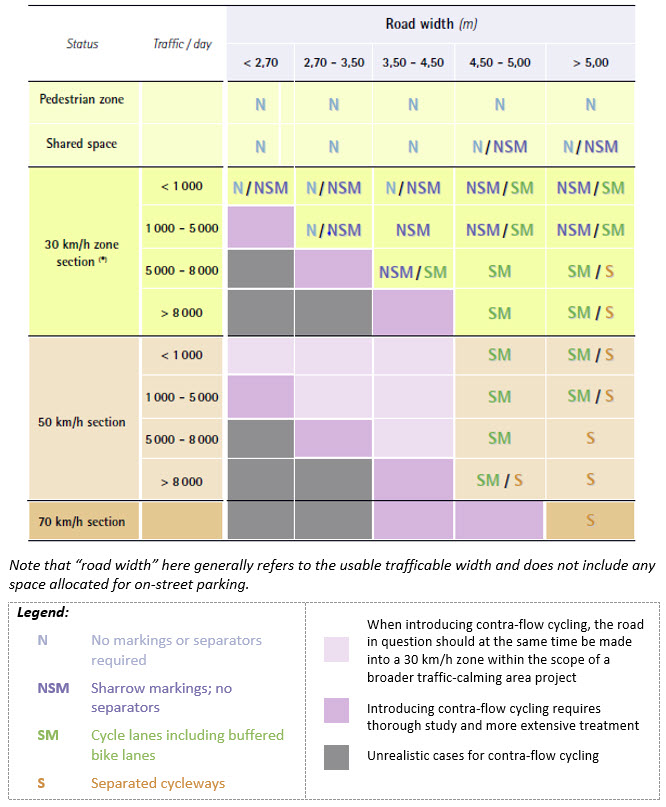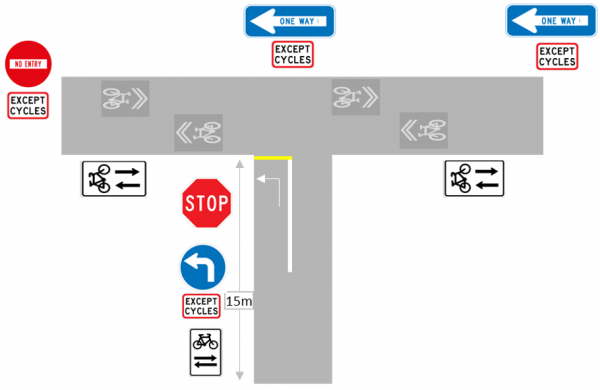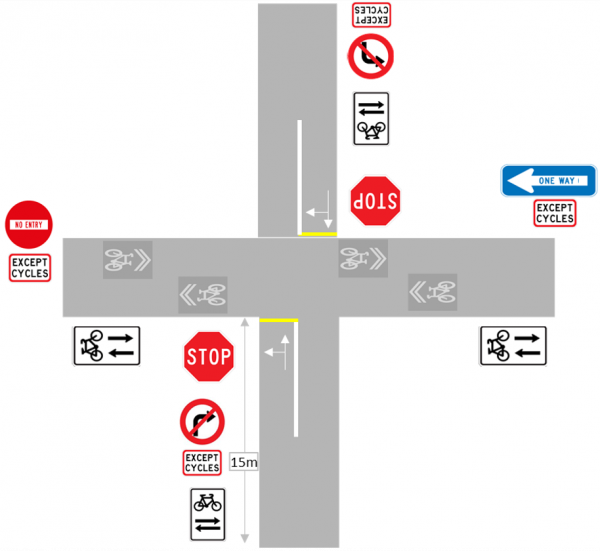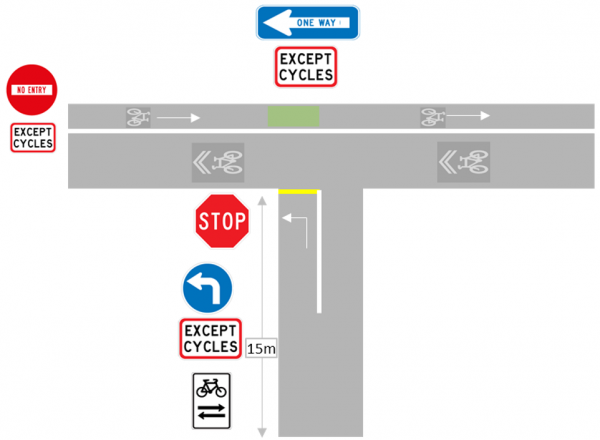Contra-flow cycle provision allows people to cycle on one-way streets in the opposing direction. These treatments help to provide improved network permeability and connectivity for cycling (relative to motor vehicles), either on existing one-way streets or those planned to be converted from two-way to one-way.
The treatments to provide for contra-flow cycling may involve physical separation (ie separated cycleways), separately marked on-road facilities (painted cycle lanes), or signage only (shared zones). It is important to consider the level of separation most appropriate for the situation.
Other than a local bylaw change controlling the allowed and prohibited movements, no legislative impediment has been identified to introducing contra-flow cycleway sections in New Zealand.
CloseThe following table from France discusses what type of contra-flow cycle provision to consider in different road and traffic situations:
Contra-flow cycle facility decision-making table (CERTU 2012)

Source: CERTU (2012). Introducing counterflow cycling: A methodological and practical guide, CERTU (Centre for the Study of Urban Planning, Transport and Public Facilities), France, 64pp. Unfortunately, the English version of this guide is no longer available for purchase, but the French version can be found at https://www.cerema.fr/fr/centre-ressources/boutique/mise-double-sens-cyclable(external link)
Greater levels of separation are recommended as traffic volumes and speeds increase, from no markings (N), to painted symbols (NSM), painted lines (SM) and physical separators (S). The guidance also acknowledges the practical difficulty of allowing contra-flow cycling as road widths get narrower (relatively few New Zealand roads would fall into the “below” 5m categories, which in practice means <9m carriageway width if the available space between parked cars either side was considered).
The above information is taken from a conference paper on “Developing Options for Contra-flow Cycleways(external link)” (Koorey et al, 2017), which also details the process undertaken to determine feasible options for contra-flow cycleways at three locations in Auckland. The options were site-specific and encompassed a range of treatments from fully separated cycleways, to on-road marked indications. Based on this, feasible options for contra-flow cycling provision in New Zealand may include:
Site-specific factors to consider include:
Signs
Motorists and cyclists alike need some indication of the presence of contra-flow cycling. At the end where traffic enters, an AU42 sign(external link) informing of oncoming cyclists may be required (see figure below) unless completely separated, while at the other end a NO ENTRY sign (R3-4) requires an EXCEPT CYCLES supplementary plate (R3-5.2).
If there are any side roads or major accesses along the street, the following advisory sign(external link) can be used to inform road users that cyclists are permitted to travel in either direction on the cycle facility that crosses at the intersection ahead of them can be used.
Generally, traffic signs(external link) must not be installed with another sign on the same pole or in the same location (with exceptions for level crossings, traffic signals, signs that relate to cyclists and to pedestrians, and parking). The following sign options may be used for different intersection situations along contra-flow cycle routes.
Section 4.5 of the Traffic Control Devices Rule states that traffic signs must not be installed with another sign on the same pole or in the same location, except if the additional sign is a supplementary sign, plate or notice (there are also exceptions specific to level crossings, traffic signals, signs that relate to cyclists and to pedestrians, and parking). The following sign options may be used for different intersection situations along contra-flow cycle routes.
|
Sign |
Reason for use at the intersection |
|
|
R3-4 No entry sign with R3-5.2 ‘Except Cycles’ supplementary. |
|
|
R3-1/R3-2 No left/right turn sign with R3-5.2 ‘Except Cycles’ supplementary. Used where a left or right turn is the only prohibited movement. ‘Except cycles’ is permitted as a supplementary(external link) to R3-1 and R3-2 excepting cycles from a ban on the movement. |
|
|
R3-8/R3-10 No left/right turn sign with R3-5.2 ‘Except Cycles’ supplementary. Used where a left or right turn is the only allowed movement. ‘Except cycles’ is permitted as a supplementary(external link) to R3-8 and R3-10 excepting cycles from the requirement to make the relevant movement. |
|
|
Inform road users that cyclists are permitted to travel in either direction on the cycle facility that crosses at the intersection ahead of them can be used. |
|
|
R3-12 One-way sign with R3-5.2 ‘Except Cycles’ supplementary. R3-12 signs must be erected on a one-way roadway at every intersection and at intervening locations near private accesses at which there are significant turning movements. ‘Except cycles’ is permitted as a supplementary(external link) to R3-12 excepting cycles from the requirement to make the relevant movement. |
The following images show how the signage could be applied on major and minor arms of intersections for the three different types of contra-flow specified in the Cycling Network Guidance:
 The above diagram shows incorporating advanced contra-flow cycling information sign for a shared space at a T-intersection. The AU42 sign should be at least 15 metres from the contra-flow facility.
The above diagram shows incorporating advanced contra-flow cycling information sign for a shared space at a T-intersection. The AU42 sign should be at least 15 metres from the contra-flow facility.

The above diagram shows incorporating advanced contra-flow cycling information sign for a shared space. The AU42 sign should be at least 15 metres from the contra-flow facility.

The above diagram shows incorporating advanced contra-flow cycling information sign for a cycle lane at the head of a T-intersection. The AU42 sign should be at least 15 metres from the contra-flow facility.

Incorporating advanced contra-flow cycling information sign for a protected cycle facility at the head of a T-intersection. The AU42 sign should be at least 15 metres from the contra-flow facility.
Markings
For other contra-flow facilities separated by markings or physical separators, standard cycle lane symbols can be used. At street ends, side-roads, and other major accesses, including an arrow with the cycle symbol (or adding the text “ONLY”) will help to reduce any confusion.
Close
These case studies are under development:
Close